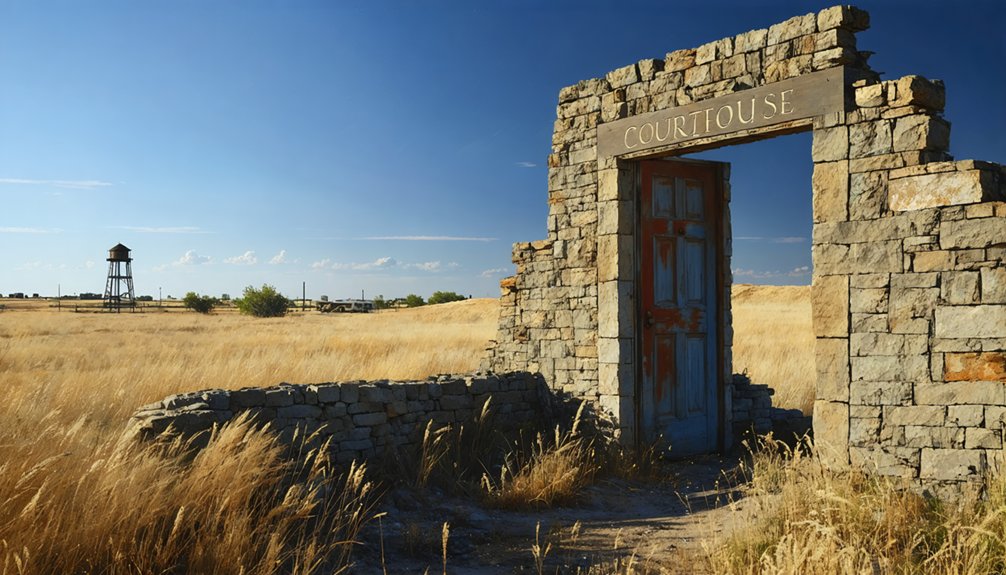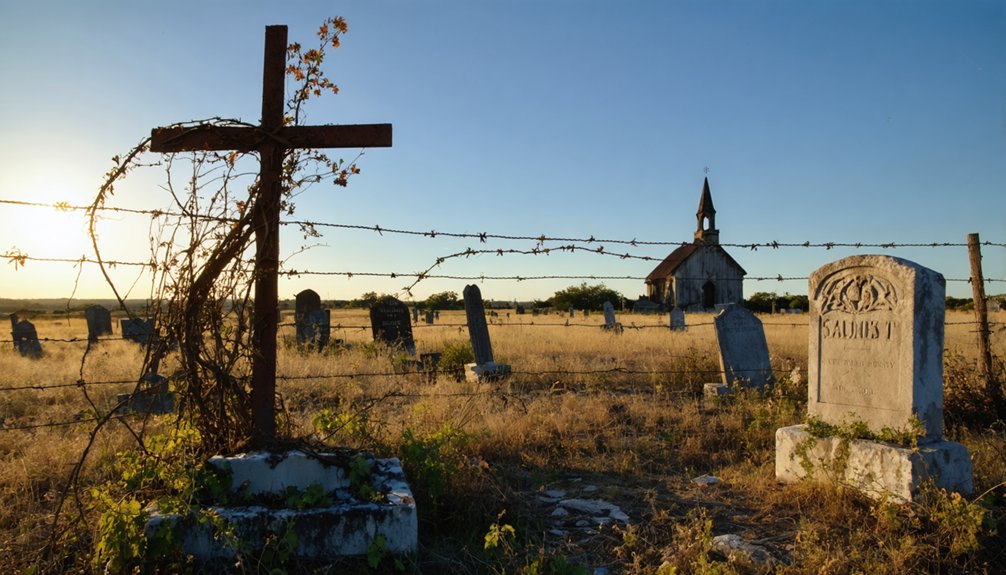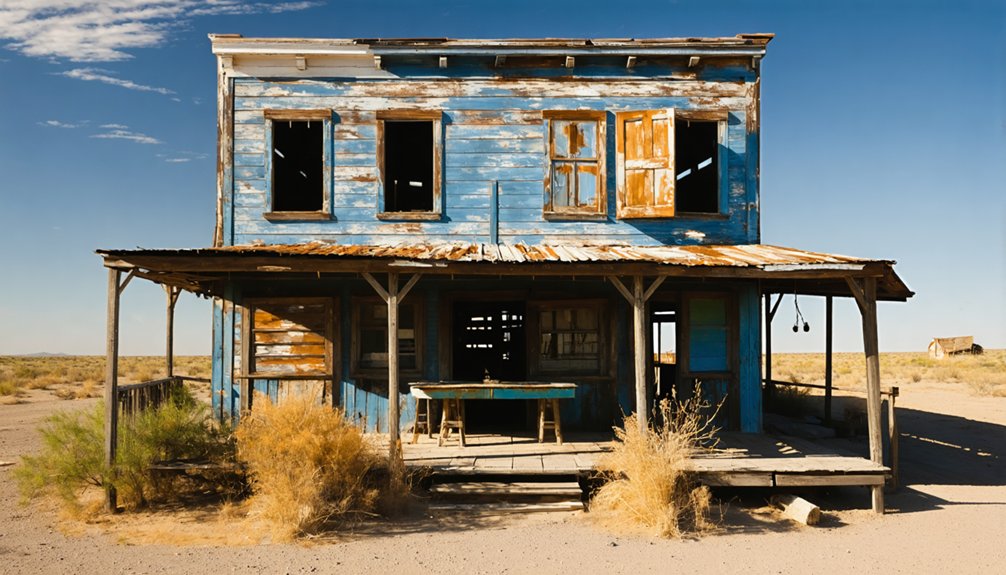You’ll find Salona’s weathered remains in Montague County, Texas, where this former cotton trade post thrived in the 1880s. The community never exceeded fifty residents but served as an essential agricultural hub until railroad construction bypassed it in favor of nearby Bowie. The town’s gradual decline led to its post office closure in 1905, leaving only a historic schoolhouse and cemetery. These quiet ruins tell a compelling story of economic transformation in rural Texas.
Key Takeaways
- Salona was a small Texas farming community that declined after being bypassed by railroad construction in favor of nearby Bowie.
- The town’s population never exceeded fifty residents and lost its post office in 1905, marking significant decline.
- Cotton farming was central to Salona’s economy during its peak in the 1880s before economic isolation led to its abandonment.
- The historic schoolhouse remains as the last significant structure, serving as a reminder of the community’s educational legacy.
- A cemetery with weathered headstones preserves the final resting place of Salona’s farming families and early settlers.
The Rise of a Cotton Empire
While Spanish missionaries first cultivated cotton in Texas during the early 1700s, the region’s true cotton empire emerged in 1821 when Anglo-American colonists began large-scale production.
You’ll find that cotton cultivation flourished between the Brazos and Colorado Rivers, particularly near San Felipe de Austin, where settlers established thriving plantations in the 1820s. Stephen F. Austin personally selected these fertile lands for their cotton-growing potential.
The economic transformation was remarkable. By 1835, Texas’s cotton sales reached 3.15 million pounds, valued at $500,000.
After Native American removal opened new lands, production skyrocketed. You can trace this growth through the numbers: Texas ranked eighth nationally in cotton production by 1852, and by 1859, output reached 431,645 bales.
Even after the Civil War’s disruptions, the industry rebounded swiftly, producing over 350,000 bales by 1869. The introduction of barbed wire and railroads in the 1870s helped drive further expansion of the cotton industry.
Railroad’s Decisive Impact
Although Salona once thrived as a bustling community center, the town’s fate changed dramatically when railroad construction bypassed it in favor of nearby locations. The railroad implications were swift and devastating, triggering an economic transformation that would reshape the entire region.
You’ll find that as new rail lines favored towns like Bowie, Salona’s residents faced mounting challenges. The swift post-Civil War expansion of rail networks throughout Texas left many small towns economically isolated. The town’s businesses struggled with increased transportation costs and limited market access, while property values plummeted. This mirrored the experience of other communities that lacked Texas & Pacific Railway access, which proved essential for commercial growth.
Without direct rail connections, local cotton production and trade opportunities dwindled. Residents began relocating to areas with better railroad access, and the closure of Salona’s post office marked a turning point in the community’s decline.
The once-prosperous settlement couldn’t compete with the railroad-connected towns, ultimately leading to its ghost town status.
Legacy in Stone and Wood
The remnants of Salona’s past endure through its weathered structures of stone and wood, offering a tangible connection to the town’s history.
You’ll find architectural decay gradually claiming these cultural relics, as nature steadily reclaims what humans left behind. Wind and rain erode the surfaces while persistent vegetation pushes through cracks in the foundations. The site evokes memories of Aldridge, where towering concrete structures create an almost temple-like atmosphere in the wilderness.
These abandoned buildings tell stories through their period-specific architectural styles, reflecting the era when Salona thrived. You can still trace the town’s heritage in the deteriorating walls and fallen beams, where wildlife now makes its home. Much like Smiley’s abandoned Chevrolet dealership, these structures stand as silent witnesses to economic decline.
While some preservation efforts exist for ghost towns in Texas, time continues its relentless march, transforming these once-proud structures into haunting monuments of a bygone era.
From Bustling Trade Post to Empty Fields
You’ll find Salona’s early promise as a cotton trade post evident in the scattered remnants of its 1880s agricultural heyday, when area farmers brought their harvests to the community’s few but essential businesses.
While the town never grew beyond fifty residents, its strategic location on Farm Road 1758 initially suggested potential for greater expansion through railway connectivity.
The community’s hopes were dashed when railroad planners chose alternate routes, leading to Salona’s gradual transformation from a modest trade center into today’s quiet fields marked only by memories of its brief commercial significance.
Like many historical places in Texas, Salona’s story teaches us the importance of preserving cultural heritage through careful documentation and research.
Like the once-prosperous port of Indianola, which fell victim to two devastating hurricanes, Salona’s story represents another Texas town that succumbed to circumstances beyond its control.
Trade Driven Cotton Glory
During cotton’s heyday in Texas, Salona transformed from a humble trading post into a bustling hub of agricultural commerce.
You’d have witnessed a remarkable economic transformation as cotton cultivation spread across the region’s fertile fields. Local farmers capitalized on the expanding railroad networks, which connected them to thriving cotton exchanges and larger markets throughout the U.S. This economic surge helped Texas contribute to 3.15 million pounds of cotton production by 1835. The development of cottonseed processing mills across Texas further expanded the industry’s reach, with the state becoming the nation’s leading processor by the end of the 19th century.
Railroad’s Fatal Decision
While Salona’s cotton trade flourished in the late 1800s, a crucial decision by railroad companies would ultimately seal the town’s fate.
As major rail lines bypassed Salona, you’d have witnessed the town’s gradual descent into obscurity. The railroad decisions reflected a broader pattern across Texas, where communities lived or died by their connection to these essential transportation arteries.
Without rail access, Salona couldn’t compete with neighboring towns that enjoyed direct routes to major markets.
- Your once-bustling cotton trading post lost its competitive edge when railroad companies chose alternative routes
- You’d have seen merchants and farmers struggle as transportation costs made their goods less profitable
- Your community’s isolation from rail networks forced businesses to relocate to better-connected towns
- You can still witness the economic impact today in Salona’s abandoned buildings and empty fields
The Birth of Bowie and Salona’s Decline

As the railroad tracks were laid near present-day Bowie in the late 19th century, Salona’s fate took a dramatic turn. The establishment of Bowie’s foundation marked the beginning of an economic shift that would reshape the entire region.
You’ll find that Salona’s residents, who’d never numbered more than fifty, began a steady migration toward the promising opportunities that Bowie offered.
The contrast couldn’t have been starker. While Bowie flourished as a bustling railroad center, Salona’s businesses dwindled. The town that once served as a crucial community hub for local farmers saw its post office close in 1905.
Preserved Memories in the Schoolhouse
As you explore the remnants of Salona’s schoolhouse, you’ll find evidence of its crucial role in educating local children through standardized curriculum and teaching methods of the era.
You can still sense the building’s significance as both an educational facility and community gathering place, where agricultural families would come together for various social events.
The final school bell may have rung decades ago, but the preserved structure stands as a memorial to Salona’s commitment to education, even as the town’s population dwindled due to the railroad’s bypass.
Teaching Through Time
Standing as a proof of rural education in early Texas, Salona’s schoolhouse remains the last significant structure in what was once a small but vibrant farming community.
You’ll find evidence of a time when education and agriculture intertwined, as local children balanced their studies with farm duties. The schoolhouse wasn’t just a place of learning – it served as a cornerstone for community gatherings and social connections in this rural settlement.
- Worn wooden floors still echo with the footsteps of students who once rushed to their morning lessons
- Simple desks and basic supplies reflect the resourcefulness of rural education
- Weathered walls stand as a testament to countless lessons taught within
- Empty windows frame views of the same farmland that sustained past generations
Last Class Bell Echoes
Though the last school bell rang over seven decades ago, Salona’s schoolhouse preserves the memories of a once-thriving rural community.
As you walk through the empty halls today, you’ll find the last remaining structure of this Texas ghost town standing as a silent witness to its rise and fall. School memories linger in the authentic furnishings, rusted bells, and faded inscriptions that mark the interior, untouched by modern renovations.
The building’s closure in the late 1940s, when the population dwindled to about thirty residents, marked more than just the end of formal education – it signaled the community’s decline.
Yet the schoolhouse endures, its community echoes preserved in the metaphorical ringing that still resonates through its weathered walls.
Stories From the Cemetery

Despite extensive research into Salona’s cemetery, few documented stories or personal accounts have emerged from this small rural burial ground. The cemetery whispers of forgotten lives from Salona’s farming past, yet records remain frustratingly silent about who rests beneath the Texas soil.
You’ll find no grand monuments or infamous tales here – just the quiet remnants of a community that once called this land home.
- The weathered stones mark the final resting place of farmers and families who worked the land from the 1870s onward.
- Each unmarked grave holds untold stories of hardship, triumph, and daily life in this farming settlement.
- The cemetery’s location near the old community center speaks to its role as the heart of Salona.
- Time and neglect threaten to erase these physical connections to the area’s agricultural heritage.
Ghosts of the Cotton Economy
Beyond the cemetery’s weathered stones lies a deeper history etched into Salona’s soil – the legacy of Texas cotton farming.
You’ll find echoes of a booming agricultural economy that transformed these lands from the 1820s through the turn of the century.
While cotton brought prosperity to landowners, it also created stark economic disparities through labor exploitation. First through slavery, then through sharecropping, workers toiled in brutal conditions while plantation owners reaped the profits.
The brutal legacy of cotton farming built wealth for plantation owners while enslaved people and sharecroppers suffered under harsh exploitation.
The arrival of cotton gins, specialized plows, and railroad connections helped drive production skyward – from 350,000 bales in 1869 to over 3.5 million by 1900.
But beneath this economic success story lies a darker tale of racial inequality and generational poverty that still haunts Texas communities like Salona today.
Frequently Asked Questions
What Was the Peak Population of Salona During Its Most Prosperous Years?
You’ll find that Salona’s historical significance peaked with just 50 residents during its most prosperous period, before experiencing population decline typical of rural Texas farming communities in the early 1900s.
Are There Any Living Descendants of Original Salona Residents Still in Texas?
You won’t find documented proof of living descendants, as family genealogy and historical records from Salona aren’t preserved in accessible archives. Any potential descendants haven’t been traced through official sources.
What Native American Tribes Inhabited the Area Before Salona’s Establishment?
You’d discover an incredibly rich tribal history where Coahuiltecan, Tonkawa, and Lipan Apache peoples made their home, with cultural significance tied to their hunter-gatherer lifestyles along Texas’s water sources.
When Was the Last Official Business or Residence Closed in Salona?
You won’t find records showing Salona’s last business closure, though ghost town history suggests the final establishments shut down sometime after the mid-1930s, when three businesses were still operating.
Is the Cemetery Still Accepting New Burials From Local Families?
Time tells all tales, but you’ll find no current cemetery regulations or burial fees posted for Salona Cemetery. Based on its ghost town status, it’s likely inactive for new burials.
References
- https://www.youtube.com/watch?v=bbVM_-giQIE
- https://www.chron.com/life/travel/article/ghost-towns-texas-18425049.php
- https://www.ghosttowns.com/states/tx/salona.html
- http://texasghosttowns.blogspot.com/2012/02/grove-coryell-county-august-2010-photos.html
- https://en.wikipedia.org/wiki/List_of_ghost_towns_in_Texas
- https://mix931fm.com/texas-ghost-towns-history/
- https://texaswanderers.com/category/historic/ghost-towns-history/
- https://www.texasescapes.com/TOWNS/Texas-Ghost-Towns-8-South-Texas.htm
- https://services.austintexas.gov/edims/document.cfm?id=307020
- https://www.tshaonline.org/handbook/entries/cotton-culture



